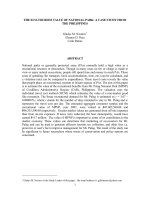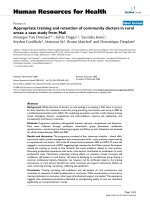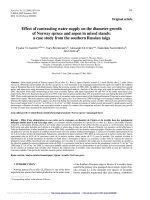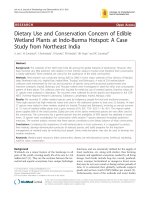Economic analysis of soil-based and soilless farming systems: A case study from Da Lat city - TRƯỜNG CÁN BỘ QUẢN LÝ GIÁO DỤC THÀNH PHỐ HỒ CHÍ MINH
Bạn đang xem bản rút gọn của tài liệu. Xem và tải ngay bản đầy đủ của tài liệu tại đây (319.22 KB, 7 trang )
<span class='text_page_counter'>(1)</span><div class='page_container' data-page=1>
<b>ECONOMIC ANALYSIS OF SOIL-BASED AND SOILLESS </b>
<b>FARMING SYSTEMS: A CASE STUDY FROM DA LAT CITY </b>
<b>Dang Duc Huya*<sub>, Pham Thi Thuyen</sub>a<sub>, Dam Thi Hai Au</sub>a<sub>, Tran Thanh Giang</sub>a<sub>, </sub></b>
<b>Nguyen Thi Tra Mya</b>
<i>a<sub>The Faculty of Economics, Nong Lam University-Ho Chi Minh City, Ho Chi Minh City, Vietnam </sub></i>
<i>*<sub>Corresponding author: Email: </sub></i>
<b>Article history </b>
Received: August 19th<sub>, 2019 </sub>
Received in revised form (1st<sub>): October 22</sub>nd<sub>, 2019 | Received in revised form (2</sub>nd<sub>): November 18</sub>th<sub>, 2019 </sub>
Accepted: November 19th<sub>, 2019 </sub>
<b>Abstract </b>
<i>Nowadays, to secure production in the case of restricted natural resources requires </i>
<i>innovative farming approaches to achieve a balance between agriculture and environmental </i>
<i>protection. This study investigates, via investment metrics and sensitivity analysis, the most </i>
<i>popular current farming practices to clarify whether or not these systems can fulfill current </i>
<i>and future demands with limited natural resources and at lowest cost. The research analyzes </i>
<i>soil-based and soilless (hydroponics and aeroponics) lettuce farming systems to highlight the </i>
<i>economic efficiency and limitations of each practice. Outcomes confirm that soilless systems </i>
<i>are more efficient in terms of production outputs than soil-based systems. The sensitivity </i>
<i>analysis of soil-based systems reveals that the impact of stochastic inputs is in the decreasing </i>
<i>magnitude of interest, gross revenue, and total operating cost. The importance of NPV varies </i>
<i>under the impact of gross revenue in the systems of hydroponics and aeroponics. This also </i>
<i>indicates that alterations in prices or output quantities are much more critical than total </i>
<i>operating cost and interest. </i>
<b>Keywords</b>: Aeroponics; Hydroponics; Sensitivity analysis; Soil-based agriculture.
DOI:
Article type: (peer-reviewed) Full-length research article
Copyright © 2020 The author(s).
</div>
<span class='text_page_counter'>(2)</span><div class='page_container' data-page=2>
<b>SO SÁNH HIỆU QUẢ KINH TẾ CỦA CÁC HỆ THỐNG CANH TÁC </b>
<b>TRÊN ĐẤT VÀ KHÔNG CẦN ĐẤT: TRƯỜNG HỢP ĐIỂN HÌNH </b>
<b>TẠI THÀNH PHỐ ĐÀ LẠT </b>
<b>Đặng Đức Huya*<sub>, Phạm Thị Thuyền</sub>a<sub>, Đàm Thị Hải Âu</sub>a<sub>, Trần Thanh Giang</sub>a<sub>, </sub></b>
<b>Nguyễn Thị Trà Mya</b>
<i>a<sub>Khoa Kinh tế, Trường Đại học Nơng Lâm TP. Hồ Chí Minh, TP. Hồ Chí Minh, Việt Nam</sub> </i>
<i>*<sub>Tác giả liên hệ: Email: </sub></i>
<b>Lịch sử bài báo </b>
Nhận ngày 19 tháng 08 năm 2019
Chỉnh sửa lần 01 ngày 22 tháng 10 năm 2019 | Chỉnh sửa lần 02 ngày 18 tháng 11 năm 2019
Chấp nhận đăng ngày 19 tháng 11 năm 2019
<b>Tóm tắt</b>
<i>Ngày nay, nhằm đảm bảo sản xuất trong điều kiện các nguồn tài nguyên thiên nhiên hạn chế </i>
<i>đòi hỏi các phương pháp sản xuất sáng tạo để đạt được sự cân bằng giữa trồng trọt và bảo </i>
<i>vệ môi trường. Nghiên cứu này điều tra các thực hành canh tác phổ biến nhất hiện nay để </i>
<i>làm sáng tỏ các hệ thống có thể đáp ứng nhu cầu hiện tại và tương lai với mức tiêu thụ tài </i>
<i>nguyên thiên nhiên và chi phí thấp nhất, thông qua việc sử dụng các chỉ số đánh giá đầu tư, </i>
<i>và phân tích độ nhạy. Nghiên cứu này tiếp cận hệ thống canh tác rau xà lách trên đất và </i>
<i>khơng cần đất (thủy canh, khí canh), để làm nổi bật khả năng kinh tế và giới hạn của mỗi </i>
<i>công nghệ. Các phát hiện cho thấy các hệ thống không đất hiệu quả hơn về sản lượng sản </i>
<i>xuất chung và hiệu quả kinh tế so với các hệ thống dựa trên đất. Kết quả phân tích độ nhạy </i>
<i>trên canh tác không dùng đất, tác động của các biến đầu vào lên Hiện giá ròng NPV giảm </i>
<i>dần theo thứ tự: Lãi suất, tổng doanh thu, và tổng chi phí vận hành. Tầm quan trọng của </i>
<i>NPV thay đổi nhiều nhất dưới tác động của tổng doanh thu trong hệ thống thủy canh và khí </i>
<i>canh, trong khi ở hệ thống dựa trên đất chỉ đứng thứ hai. Tác động lớn nhất của tổng doanh </i>
<i>thu cũng cho thấy sự thay đổi đến từ giá bán hoặc sản lượng đầu ra, quan trọng hơn nhiều </i>
<i>so với chi phí hoạt động và lãi suất. </i>
<b>Từ khóa: </b>Canh tác trên đất; Khí canh; Phân tích độ nhạy; Thuỷ canh.
DOI:
Loại bài báo: Bài báo nghiên cứu gốc có bình duyệt
Bản quyền © 2020 (Các) Tác giả.
</div>
<span class='text_page_counter'>(3)</span><div class='page_container' data-page=3>
<b>1. </b> <b>INTRODUCTION </b>
Nowadays, assuring adequate supplies of clean, safe food has become pivotal in
the context of the global population boom (Alexandratos & Bruinsma, 2012) and the
rising awareness of consumers regarding the quality, quantity, and safety of food (Dang
& Tran, 2020a, 2020b; Putra & Yuliando, 2015). According to the forecast of the Food
and Agriculture Organization, the world will need 70% more food to feed 9.1 billion
people in 2050 (FAO, 2009). Hence, sustainable farming in parallel with the population
growth rate has become essential (Dang, 2020).
Soil-based farming is still the predominant means of producing food. However,
novel farming practices, such as irrigation technologies, polyhouses, rotation, and
intercropping, are gaining great traction. To reach their potential, environmental
trade-offs deems in place (Gomiero, Pimentel, & Paoletti, 2011). To maximize efficiency,
traditional agriculture overuses inputs of agricultural chemicals, leading to negative
environmental consequences (AlShrouf, 2017), such as soil degradation accompanied by
erosion (Barbosa et al., 2015). Besides, the land is increasingly impoverished owing to
the loss of beneficial microorganisms (Barman, Mehedi, Rezuanul, & Banu, 2016) and
continuous farming plus adverse weather, poor management of water resources, and
groundwater depletion threaten soil-based faming.
Under the above mentioned conditions, cutting-edge farming practices are
expected to foster a more sustainable agriculture (Lakhiar, Gao, Syed, Chandio & Buttar,
2018). Soilless farming (hydroponics and aeroponics) is expected to be the holy grail in
modern agriculture (AlShrouf, 2017). These farming systems can reduce 98% of water
demand, 60% of fertilizer, and 100% of pesticide/insecticide use while optimizing yield
from 45% to 75% (NASA, 2006). These solutions offer a more sustainable pathway to
overcome environmental and economic problems while still balancing nutrient quality
(Barbosa et al. 2015).
In the context of Vietnam, soilless farming has been widely adopted mainly for
growing leafy green vegetables. Hydroponics is currently being adopted more often than
aeroponics. However, the analysis of the case study of aeroponics in Da Lat city fits well
to complement the missing piece of the full picture of soilless farming practice.
</div>
<span class='text_page_counter'>(4)</span><div class='page_container' data-page=4>
for optimal results (Quagrainieet al., 2018). On the other hand, the financial analysis of
Mattas, Bentes, Paroussi, and Tzouramani (1997) found that hydroponics does not achieve
economic efficiency for Greek farmers because of the high capital investment and fuel
costs. Souza, Gimenes, and Binotto (2019) also noted that farmers need to be aware of
the heavy capital investment required by hydroponics. Previous work did not delve into
the necessary risk-oriented elements, such as price, quantity, cost of production, and
interest. The lack of necessary scientific information could hinder the adoption of new
technologies in Vietnam.
By virtue of this, the assessment of the pros and cons of soilless farming systems
(hydroponics and aeroponics) against soil-based systems is critical in the context of the
transition of agriculture toward a more modern, sustainable system in Vietnam. For that
reason, this paper aims at clarifying the advantages and disadvantages of farming systems
from an economic feasibility standpoint. The analytical assessment is expected to benefit other
developing countries in the same phase of converting to high-tech agriculture as Vietnam.
<b>2. </b> <b>RESEARCH BACKGROUND </b>
With 4,400 ha of polyhouses and 1,200 ha of nethouses, Lam Dong is the leading
province in high-tech agriculture nationwide, and Da Lat city holds 2,760 ha of
greenhouses including 1,250 ha for vegetable production (Lâm, 2018). Utilizing
greenhouses in vegetable cultivation yields advantages. In fact, while farmers from other
provinces have incomes of approximately 100 million VND/ha/year, high-tech vegetable
farmers in Da Lat can make around 500 to 600 million VND/ha/year. According to the
Department of Agriculture and Rural Development of Lam Dong province, the area
devoted to greenhouses has increased by 300 to 350 ha annually since 2010. Specialized
vegetable growing areas have formed beside flower village, and many advanced
technologies were absorbed and applied by Da Lat farmers to production. In addition to
greenhouses, sprinkler systems, drip irrigation with fertilizer, lighting technology to
modify growth time, tissue culture technology in plant propagation, and modern farming
technologies, such as hydroponics and automatic farming have also been applied
effectively (Nguyễn, 2016).
In addition to the positive results, the application of high-tech agricultural
production still has several shortcomings. The application of postharvest technology,
preservation and processing is limited. The price of agricultural products is not stable. The
consumer market is still difficult, and the rate of agricultural exports is still low. Farmers
lack capital (Dang, Dam, Pham, & Nguyen, 2019) and are not bold enough to invest in
new technology. The link between farmers and businesses and cooperatives is not yet tight
in the production and consumption stages.
</div>
<span class='text_page_counter'>(5)</span><div class='page_container' data-page=5>
farming systems such as hydroponics and aeroponics that are able to control and use
fertilizers in permissible and economical doses has become essential to ensure quality while
still creating a significant source of income for farmers. In particular, the research of Lê,
Nguyễn, Nguyễn, and Nguyễn (2016) indicated that the level of copper accumulation in the
soil affects the growth of some vegetables. Although the lack of the required amount of
copper limits the growth of crops, an excess is toxic to plants. The use of coal to absorb
wastewater affects NH3 emissions and the growth of lettuce. Specifically, the coal can be
reused after the adsorption of biogas wastewater as a fertilizer source for plants while
minimizing environmental contamination (Huỳnh, Nguyễn, Phan, & Ngô, 2011).
These studies reveal that soil-based farming provides certain disadvantages and
difficulties. A study pointed out that selecting diversified led lighting and various light
durations could influence the growth and yield of lettuce grown hydroponically in Can
Tho city (Vietnam), and, of course, growers can also opt for optimal led types and lighting
times (Phan, Ngô, Nguyễn, Tống, Võ, & Trần, 2016). Research in Thua Thien-Hue
province (Vietnam) showed that the concentrations of NQ2 nutrient solution have a good
influence on the growth, yield, and economic efficiency of spring lettuce, but specifically,
the formula for mixing a solution of 1,000 ppm concentration of nutrient solution is the
best (Lê & Nguyễn, 2015). The work of Đỗ, Hà, Lê, and Phạm (2016) resulted in a strong
correlation between the amount of manure and the organic content in intensive vegetable
soil in Lam Dong province. Besides, it is clear that cultivation by hydroponic and
aeroponic methods has the outstanding advantage of being able to take the initiative in
nutrients and stimulate the development of economically efficient cultivation methods
backed by scientific evidence. Based on that fact, this study is performed to contribute a
more theoretical basis for the scientific view of the economics of this matter.
<b>3. </b> <b>METHODOLOGY </b>
<b>3.1. </b> <b>Description of farming systems </b>
In terms of characteristics, there are many farming systems depending on the
definition of the output, the technology of application, and the practice. Therefore, this study
was conducted based on some brief definitions of comparable systems, as shown below:
• <i>Soil-based farming (traditional): </i>Crops are grown in soil and in greenhouses.
Modern irrigation systems are used (drip irrigation or spray irrigation).
Fertilizers and pesticides are used in traditional farming<i>. </i>
• <i>Hydroponics: </i>A method of growing plants in a mixed nutrient solution. The
plant grows on an inert substrate (coir) and its roots are in contact with the
nutrient solution.
</div>
<span class='text_page_counter'>(6)</span><div class='page_container' data-page=6>
<b>3.2. </b> <b>Data collection </b>
Data were collected in December 2018 using a structured questionnaire given to
lettuce growing households in Dalat, Lam Dong Province. The questionnaire covered
investment costs, variable costs, revenue, and the socio-economic characteristics of the
farm. The questionnaire was checked and pilot tested first to determine the intelligibility
and meaning of the questionnaire. Farmers were selected at random using the snowball
method; they included 68 households growing lettuce (60 soil-based, seven hydroponic,
and one aeroponic). The sample of soilless farming households was limited due to their
scattered nature, limited number, and the inaccessibility of some households during the
research process. Two outliers were rejected because they were greater than two standard
deviationss. Therefore, the remaining 66 observations were used for analysis.
<b>3.3. </b> <b>Comparison between soil-based and soilless farming </b>
Capital budgeting is an appropriate approach to assess the economic efficiency of
farming systems. Net present value (<i>NPV</i>) was used to evaluate economic efficiency over
the lifetime of the project using Equation (1).
𝑁𝑃𝑉 = −𝐶𝐹0+ ∑
𝑁𝐶𝐹𝑡
(1+𝑖)𝑡
𝑛
𝑡=1 (1)
where <i>CF0 </i>is the initial investment, <i>NCFt</i> is the net cash flow in period <i>t</i>, equal to
the annual cash flow minus the total annual operation cost, 𝑖 is the discount rate, and 𝑛 is
the lifespan of the investment. The economic analysis was conducted for farming systems
with an assumed lifespan of 10 years. After the 10th year, most of the important equipment
requires reinvestment. Thus, 10 years is long enough to provide a full picture of profit for
the project life cycle, assuming no unexpected uncertainties.
Other financial indices were also used, such as: internal rate of return (<i>IRR</i>),
modified internal rate of return (<i>MIRR</i>), discounted payback period (<i>DPP</i>), and benefit
cost ratio (<i>BCR</i>). Internal rate of return (<i>IRR</i>) is a classical economic instrument used to
balance discounted cash flow created within the lifespan of the project with the initial
investment (Equation 2).
∑
𝑅𝑡(1+𝐼𝑅𝑅)𝑡
𝑛
𝑡=0
− ∑
𝐶𝑡
(1+𝐼𝑅𝑅)𝑡
=
0𝑛
𝑡=0 (2)
where <i>Rt</i> is the revenue generated during time <i>t</i>, <i>Cj</i> is the cost at time <i>t</i>, <i>t</i> is the time
of occurrence of <i>Rt</i>and <i>Ct</i>, and 𝑛 is the project life cycle. Moreover, <i>MIRR</i> is used to
overcome the weakness of <i>IRR</i> and solve the re-investment rate issue.
</div>
<span class='text_page_counter'>(7)</span><div class='page_container' data-page=7>
𝐵𝐶𝑅
=
∑ 𝑅𝑡
(1+𝑖)𝑡
𝑛
𝑡=0
∑ 𝐶𝑡
(1+𝑖)𝑡
𝑛
𝑡=0
(3)
where <i>BCR</i> is the benefit-cost ratio, <i>Rt</i> is the revenue at time <i>t</i>, <i>Ct</i> is the cost at
time <i>t</i>, 𝑖 is the discounted interest rate, <i>t</i> is the time of occurrence of <i>Rt</i> and <i>Ct</i>, and 𝑛 is
the project life cycle.
The discounted payback period (<i>DPP</i>) assesses the economic efficiency of an
investment per unit of time. This criterion evaluates the number of years of payback from
the net cash flow, discounting the value of the currency over time (Equation 4).
𝐷𝑃𝑃
=
𝐴+
𝐵<sub>𝐶</sub> (4)where <i>A</i> is the final stage with the cumulative cash flow at a negative discount,<i> B</i>
is the absolute value of the discounted cumulative cash flow at the end of phase<i> A, </i>and<i> C </i>
is the discounted cash flow post<i> A.</i>
The modified internal rate of return (<i>MIRR</i>) is a measure of the financial
attractiveness and ranking of investment projects. The <i>MIRR</i> removes the possible
mathematical uncertainty in nonconventional cash flows and the <i>IRR</i> reinvested from the
market (assuming the IRR). <i>MIRR</i> is more advantageous than <i>IRR</i> because it is an
indicator of the real rate of return/long-term rate of return of a project (Equation 5).
𝑀𝐼𝑅𝑅 = √𝐹𝑉(𝑃𝑜𝑠𝑖𝑡𝑖𝑣𝑒 𝑐𝑎𝑠ℎ 𝑓𝑙𝑜𝑤𝑠 𝑥 𝐶𝑜𝑠𝑡 𝑜𝑓 𝑐𝑎𝑝𝑖𝑡𝑎𝑙)<sub>𝑃𝑉 (𝐼𝑛𝑖𝑡𝑖𝑎𝑙 𝑜𝑢𝑡𝑙𝑎𝑦𝑠 𝑥 𝐹𝑖𝑛𝑎𝑛𝑐𝑖𝑛𝑔 𝑐𝑜𝑠𝑡)</sub> − 1 (5)
where <i>n</i> is the equal amount of time at the end of the cash flow occurring, PV is
the present value (at the beginning of the first period), 𝑃𝑉 = 𝐶𝐹<sub>0</sub> − ∑ 𝐶𝐹𝑖
(1+𝑟)𝑖 , and <i>FV</i> is
the future value (at the end of the final period), 𝐹𝑉 = ∑𝑛<sub>𝑖=1</sub>𝐶𝐹<sub>𝑖</sub>(1 + 𝑟<sub>𝑒</sub>)𝑖−1.
<b>3.4. Sensitivity analysis </b>
</div>
<!--links-->









